Assessment of a Non-Destructive Testing Method Using Ultrasonic Pulse Velocity to Determine the Compressive Strength of Rubberized Bricks Produced with Lime Kiln Dust Waste
Abstract
:1. Introduction
2. Materials and Methods
2.1. Materials
2.1.1. LKD and GGBFS
2.1.2. Sand
2.1.3. Fine Waste Tire Crumb Rubber (WTCR)
2.2. Methods
2.2.1. Mix Design
2.2.2. Preparation and Curing of Samples
- The greased formworks were placed on a vibrating table, and the mix was transferred into the forms in 3 layers. For the first and second layers, the vibration lasted for 40 s, and for the final layer, the vibration lasted for 120 s. After that, the excess material above the formworks was struck off to give a leveled and smooth surface, as shown in Figure 6.
- The bricks were allowed to sit for 48 h before de-molding. Immediately after de-molding, the samples were sprayed with water and wrapped in layers of cling film to retain the moisture and were kept in a controlled environment with an average humidity and temperature of 79% (±5%) and 19 °C (±5 °C), respectively, to enhance the moist curing (Figure 7).
- Spraying of the samples continued every other day for 7, 14, and 28 days, respectively. When the respective curing durations had elapsed, the samples were unwrapped and air-dried for 3–5 days, and then the NDT (UPV) and the DT (compression) tests were carried out.
3. Testing of Bricks
3.1. NDT: Ultrasonic Pulse Velocity (UPV) Test
3.2. DT: Compression Strength (CS) Tests
- Ka = aspect ratio factor determined with respect to the brick’s height-to-thickness ratio
- P = Load at which failure of the brick specimen occurs (kN)
- A = Area of the brick sample (mm2)
- CS = Compressive strength of the brick sample (MPa)
4. Discussion of Results
4.1. Ultrasonic Pulse Velocity (UPV) Test
4.2. Compression Strength Test
4.3. Comparison of UPV and CS Using Developed Models
- fc = compressive strength;
- Vp = wave velocity for P waves;
- Vs = velocity for S waves.
5. Conclusions
- The LKD-GGBFS blend is a suitable alternative to OPC that can be used to produce eco-friendly rubberized bricks.
- WTCR can be replaced by up to 5% of the volume of sand to give a CS value of not less than 5 MPa after a 28-day curing period, as recommended for solid or cored load-bearing masonry units in small buildings [59].
- WTCR can be replaced by up to 10% of the volume of sand to give a CS value of not less than 3 MPa after a 28-day curing period, as recommended for solid or cored non-load-bearing masonry units in small buildings [59].
- P waves are recommended for carrying out UPV tests due to their stable and higher velocities, as seen in the results presented in this study.
- The power model for the P waves gave the most preferred relationship with an acceptable trendline presentation. Hence, it is an acceptable model for correlating the CS value and the wave velocity for rubberized bricks produced with the LKD-GGBFS blend considered in this study.
- The developed power model can be useful for predicting laboratory crushing test strength values when cast samples are unavailable. However, further investigation is required to verify this model, considering different factors such as the cementitious material, the aggregate type and size, the water-cement/binder ratios, the specimen sizes, and the curing time.
Author Contributions
Funding
Data Availability Statement
Acknowledgments
Conflicts of Interest
References
- Munier, N. Multicriteria Environmental Assessment; Kluwer Academic Publishers: Dordrecht, The Netherlands, 2004. [Google Scholar]
- Loux, N.T.; Su, Y.S.; Hassan, S.M. Issues in assessing environmental exposures to manufactured nanomaterials. Int. J. Environ. Res. Public Health 2011, 8, 3562–3578. [Google Scholar] [CrossRef] [PubMed]
- Abbasi, T.; Abbasi, S.A. Water quality indices based on bioassessment: The biotic indices. J. Water Health 2011, 9, 330–348. [Google Scholar] [CrossRef] [PubMed]
- Yuan, H. A model for evaluating the social performance of construction waste management. Waste Manag. 2012, 32, 1218–1228. [Google Scholar] [CrossRef] [PubMed]
- Intergovernmental Panel on Climate Change (IPCC). Sources of CO2. In Carbon Dioxide Capture and Storage; IPCC: Geneva, Switzerland, 2004; pp. 77–103. [Google Scholar]
- World Business Council for Sustainable Development (WBCSD). The Cement Sustainability Initiative—Our Agenda for Action; WBCSD: Geneva, Switzerland, 2002. [Google Scholar]
- UNEP. Global Status Report Towards a Zero-Emission, Efficient and Resilient Buildings and Construction Sector; UNEP: Nairobi, Kenya, 2018. [Google Scholar]
- Gartner, E. Industrially interesting approaches to ‘low CO2’ cements. Cem. Concr. Res. 2004, 34, 1489–1498. [Google Scholar] [CrossRef]
- Hewlett, P.C. (Ed.) Lea’s Chemistry of Cement and Concrete, 4th ed.; Elsevier: Amsterdam, The Netherlands, 1998. [Google Scholar]
- World Bank (WB). Construction Industry Value Chain; World Bank: Washington, DC, USA, 2018. [Google Scholar]
- Duan, P.; Yan, C.; Zhou, W.; Luo, W.; Shen, C. An investigation of the microstructure and durability of a fluidized bed fly ash–metakaolin geopolymer after heat and acid exposure. Mater. Des. 2015, 74, 125–137. [Google Scholar] [CrossRef]
- Mahoutian, M.; Shao, Y. Production of cement-free construction blocks from industry wastes. J. Clean. Prod. 2016, 137, 1339–1346. [Google Scholar] [CrossRef]
- Kuo, W.; Wang, H.; Shu, C. Engineering properties of cementless concrete produced from GGBFS and recycled desulfurization slag. Constr. Build. Mater. 2014, 2014, 189–196. [Google Scholar] [CrossRef]
- Siddique, R.; Naik, T.R. Properties of concrete containing scrap-tire rubber—An overview. Waste Manag. 2004, 24, 563–569. [Google Scholar] [CrossRef]
- Ho, A.C.; Turatsinze, A.; Hameed, R.; Vu, D.C. Effects of rubber aggregates from grinded used tires on the concrete resistance to cracking. J. Clean. Prod. 2012, 23, 209–215. [Google Scholar] [CrossRef]
- Issa, C.A.; Salem, G. Utilisation of recycled crumb rubber as fine aggregates in concrete mix design. Constr. Build. Mater. 2013, 42, 48–52. [Google Scholar] [CrossRef]
- Zahid Hossain, F.M.; Shahjalal Md Islam, K.; Tiznobaik, M.; Shahria Alam, M. Mechanical properties of recycled aggregate concrete containing crumb rubber and polypropylene fiber. Constr. Build. Mater. 2019, 225, 983–996. [Google Scholar] [CrossRef]
- Mohajerani, A.; Burnett, L.; Smith, J.V.; Markovski, S.; Rodwell, G.; Rahman, M.T.; Kurmus, H.; Mirzababaei, M.; Arulrajah, A.; Horpibulsuk, S.; et al. Recycling waste rubber tires in construction materials and associated environmental considerations: A review. Resour. Conserv. Recycling. 2020, 155, 104679. [Google Scholar] [CrossRef]
- Thakur, A.; Senthil, K.; Singh, A.P. Experimental investigation on crumb rubber based concrete bricks along with polypropylene and steel fibers. Asian J. Civ. Eng. 2022, 23, 357–374. [Google Scholar] [CrossRef]
- Zhang, Z.; Ma, H.; Qian, S. Investigation on properties of ECC incorporating crumb rubber of different sizes. J. Adv. Concr. Technol. 2015, 13, 241–251. [Google Scholar] [CrossRef]
- Azevedo FPacheco-Torgal, F.; Jesus, C.; Barroso de Aguiar, J.L.; Camões, A.F. Properties and durability of HPC with tyre rubber wastes. Constr. Build. Mater. 2012, 34, 186–191. [Google Scholar] [CrossRef]
- Siddika, A.; Mamun, M.A.A.; Alyousef, R.; Amran, Y.H.M.; Aslani, F.; Alabduljabbar, H. Properties and utilizations of waste tire rubber in concrete: A review. Constr. Build. Mater. 2019, 224, 711–731. [Google Scholar] [CrossRef]
- Youssf, O.; Mills, J.E.; Hassanli, R. Assessment of the mechanical performance of crumb rubber concrete. Constr. Build. Mater. 2016, 125, 175–183. [Google Scholar] [CrossRef]
- Thomas, B.S.; Gupta, R.C. Long term behaviour of cement concrete containing discarded tire rubber. J. Clean. Prod. 2015, 102, 78–87. [Google Scholar] [CrossRef]
- Hoła, A.; Sadowski, L.; Szymanowski, J. Non-destructive testing and analysis of a xix-century brick masonry building. Arch. Civ. Eng. 2020, 66, 201–219. [Google Scholar] [CrossRef]
- Aliabdo, A.A.E.; Elmoaty, A.E.M.A. Reliability of using nondestructive tests to estimate compressive strength of building stones and bricks. Alex. Eng. J. 2012, 51, 193–203. [Google Scholar] [CrossRef]
- Noor-E-Khuda, S.; Albermani, F. Mechanical properties of clay masonry units: Destructive and ultrasonic testing. Constr. Build. Mater. 2019, 219, 111–120. [Google Scholar] [CrossRef]
- Lee, Y.H.; Oh, T. The Measurement of P-, S-, and R-Wave Velocities to Evaluate the Condition of Reinforced and Prestressed Concrete Slabs. Adv. Mater. Sci. Eng. 2016, 2016, 1548215. [Google Scholar] [CrossRef]
- Mohammed, B.S.; Abdullahi, M.; Hoong, C.K. Statistical models for concrete containing wood chipping as partial replacement to fine aggregate. Constr. Build. Mater. 2014, 55, 13–19. [Google Scholar] [CrossRef]
- Lin, S.; Tang, X.; Li, H.-N.; Gucunski, N.; Wang, Y. Non-destructive Evaluation of Concrete Compressive Strength Using Shear-Horizontal Waves. J. Perform. Constr. Facil. 2023, 37, 06022002. [Google Scholar] [CrossRef]
- Noor-E-Khuda, S.; Albermani, F.; Veidt, M. Flexural strength of weathered granites: Influence of freeze and thaw cycles. Constr. Build. Mater. 2017, 156, 891–901. [Google Scholar] [CrossRef]
- Mahmutoğlu, Y. Prediction of weathering by thermal degradation of a coarse-grained marble using ultrasonic pulse velocity. Environ. Earth. Sci. 2017, 76, 435. [Google Scholar] [CrossRef]
- Cardani, G.; Cantini, L.; Munda, S.; Zanzi, L.; Binda, L. Non invasive measurements of moisture in full-scale stone and brick masonry models after simulated flooding: Effectiveness of GPR. In Nondestructive Testing of Materials and Structures; Springer: Dordrecht, The Netherlands, 2013; pp. 1143–1149. [Google Scholar]
- Yilmaz, T.; Ercikdi, B.; Karanam, K.; Külekçi, G. Assessment of strength properties of cemented paste backfill by ultrasonic pulse velocity test. Ultrasonics 2014, 54, 1386–1394. [Google Scholar] [CrossRef]
- Mohammed, B.S.; Azmi, N.J.; Abdullahi, M. Evaluation of rubbercrete based on ultrasonic pulse velocity and rebound hammer tests. Constr. Build. Mater. 2011, 25, 1388–1397. [Google Scholar] [CrossRef]
- Yaman, I.O.; Inci, G.; Yesiller, N.; Aktan, H.M. Ultrasonic pulse velocity in concrete using direct and indirect transmission. ACI Mater. J. 2001, 98, 450–457. [Google Scholar]
- Choi, Y.; Kim, I.-H.; Lim, H.-J.; Cho, C.-G. Investigation of Strength Properties for Concrete Containing Fine-Rubber Particles Using UPV. Materials 2022, 15, 3452. [Google Scholar] [CrossRef]
- Marie, I. Zones of weakness of rubberised concrete behavior using the UPV. J. Clean. Prod. 2016, 116, 217–222. [Google Scholar] [CrossRef]
- Latif, M.; Naganathan, S.; Razak, H.; Mustapha, K. Performance of lime kiln dust as cementitious material. Procedia Eng. 2015, 125, 780–787. [Google Scholar] [CrossRef]
- ASTM C150/C150M-2; Standard Specification for Portland Cement. ASTM: West Conshohocken, PL, USA, 2021.
- Arulrajah, A.; Mohammadinia, A.; D’Amico, A.; Horpibulsuk, S. Effect of lime kiln dust as an alternative binder in the stabilisation of construction and demolition materials. Constr. Build. Mater. 2017, 152, 999–1007. [Google Scholar] [CrossRef]
- Kakrasul, J.; Parsons, R.; Han, P. Lime Kiln Dust for Treated Subgrades; The University of Kansas: Lawrence, KS, USA, 2017. [Google Scholar]
- Bediako, M.; Amankwah, E.O. Analysis of Chemical Composition of Portland Cement in Ghana: A Key to Understand the Behavior of Cement. Hindawi Publ. Corp. Adv. Mater. Sci. Eng. 2015, 2015, 349401. [Google Scholar] [CrossRef]
- AS 1141.11.1; Methods for Sampling and Testing Aggregates. Standards Australia: Sydney, NSW, Australia, 2020.
- ASTM C33/C33M; Standard Specifications for Concrete Aggregates. ASTM: West Conshohocken, PL, USA, 2013.
- Frasson, A., Jr.; Casali, J.M.; Olivera, A.L.; Prudêncio, L.R., Jr. A Mix Design Methodology for Concrete Block Units. In Proceedings of the 15th International Brick and Block Masonry Conference, Florianópolis, Brazil, 3–6 June 2012. [Google Scholar]
- Guo, S.; Dai, Q.; Si, R.; Sun, X.; Lu, C. Evaluation of properties and performance of rubber-modified concrete for recycling of waste scrap tire. J. Clean. Prod. 2017, 14, 681–689. [Google Scholar] [CrossRef]
- Najim, K.B.; Hall, M.R. Mechanical and dynamic properties of self-compacting crumb rubber modified concrete. Constr. Build. Mater. 2012, 27, 521–530. [Google Scholar] [CrossRef]
- Strukar, K.; Kalman, T.K.; Miličević, I.; Bušić, R. Potential use of rubber as aggregate in structural reinforced concrete element1A review. Eng. Struct. 2019, 188, 452–468. [Google Scholar] [CrossRef]
- Hesami, S.; Hikouei, I.S.; Emadi, S.A.A. Mechanical behavior of self-compacting concrete pavements incorporating recycled tire rubber crumb and reinforced with polypropylene fiber. J. Clean. Prod. 2016, 133, 228–234. [Google Scholar] [CrossRef]
- Shu, X.; Huang, B. Recycling of waste tire rubber in asphalt and portland cement concrete: An overview. Constr. Build. Mater. 2014, 67, 217–224. [Google Scholar] [CrossRef]
- Shen, W.; Shan, L.; Zhang, T.; Ma, H.; Cai, Z.; Shi, H. Investigation on polymer-rubber aggregate modified porous concrete. Constr. Build. Mater. 2013, 38, 667–674. [Google Scholar] [CrossRef]
- Segre, N.; Joekes, I. Use of tire rubber particles as addition to cement paste. Cem. Concr. Res. 2000, 30, 1421–1425. [Google Scholar] [CrossRef]
- Tian, S.; Zhang, T.; Li, Y. Research on modifier and modified process for rubber-particle used in rubberised concrete for road. Adv. Mater. Res. 2011, 243, 4125–4130. [Google Scholar] [CrossRef]
- Mohammadi, I.; Khabbaz, H.; Vessalas, K. Enhancing mechanical performance of rubberised concrete pavements with sodium hydroxide treatment. Mater. Struct. 2016, 49, 813–827. [Google Scholar] [CrossRef]
- Niş, A.; Eren, N.A.; Çevik, A. Effects of recycled tyre rubber and steel fibre on the impact resistance of slag-based self-compacting alkali-activated concrete. Eur. J. Environ. Civ. Eng. 2023, 27, 519–537. [Google Scholar] [CrossRef]
- Priyadharshini, M.; Naveen Kumar, M. Experimental Study on Crumb Rubber with Partial Replacement of Fine Aggregate. Int. Res. J. Eng. Technol. 2018, 5, 4584–4590. [Google Scholar]
- AS 3700; Masonry Structures. Standards Australia: Sydney, NSW, Australia, 2018.
- AS 4773.2; Masonry in Small Buildings Construction. Standards Australia: Sydney, NSW, Australia, 2015.
- ASTM C1383-04; Standard Test Method for Measuring the P-Wave Speed and the Thickness of Concrete Plates Using the Impact-Echo Method. ASTM: West Conshohocken, PL, USA, 2009.
- AS 1012.9; Methods of Testing Concrete. Compressive Strength Test-Concrete, Mortar and Grout Specimens. Standards Australia: Sydney, NSW, Australia, 2014.
- AS/NZS 4456.4; Masonry Units, Segmental Pavers and Flags—Methods of Test, Method 4: Determining Compressive Strength of Masonry Units. Standards Australia: Sydney, NSW, Australia, 2003.
- Demirboğa, R.; Türkmen, İ.; Karakoç, M.B. Relationship between ultrasonic velocity and compressive strength for high-volume mineral-admixtured concrete. Cem. Concr. Res. 2004, 34, 2329–2336. [Google Scholar] [CrossRef]
- Sabbağ, N.; Uyanık, O. Prediction of reinforced concrete strength by ultrasonic velocities. J. Appl. Geophys. 2017, 141, 13–23. [Google Scholar] [CrossRef]
- Yang, S.; Zhu, H.; Xu, Z. Prediction of compressive strength of concrete using double-shear testing method. J. Mater. Civ. Eng. 2021, 33, 04020423. [Google Scholar] [CrossRef]
- Neville, A.M. Properties of Concrete, 3rd ed.; Longman: Singapore, 1995. [Google Scholar]
- Tharmaratnam, K.; Tan, B.S. Attenuation of ultrasonic pulse in cement mortar. Cem. Concr. Res. 1990, 20, 335–345. [Google Scholar] [CrossRef]


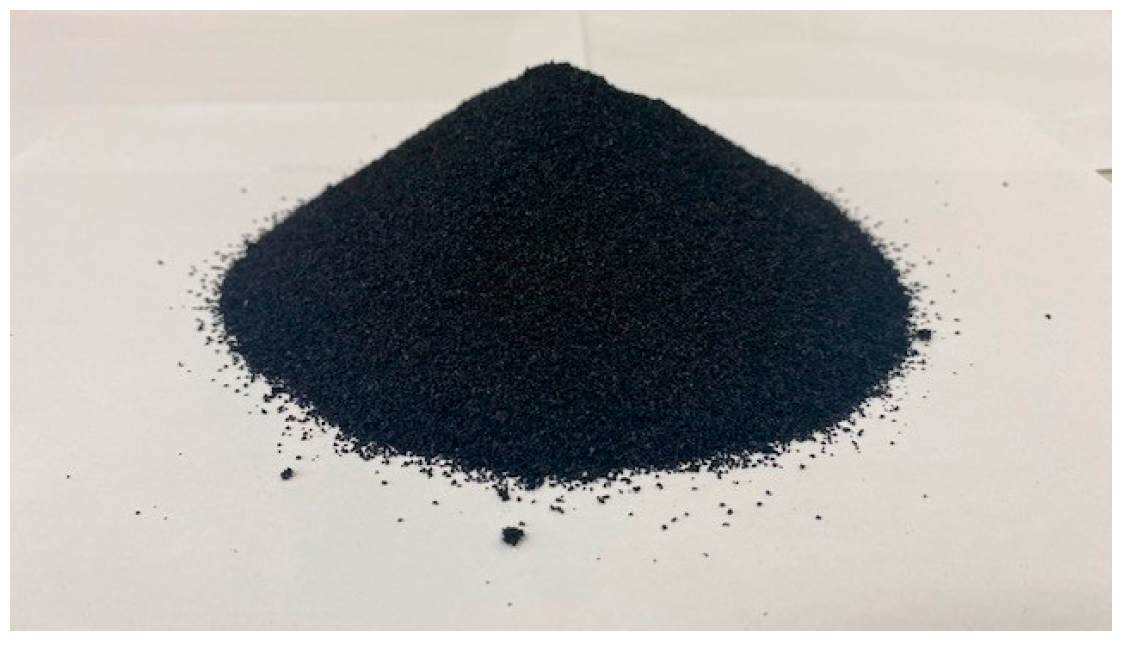


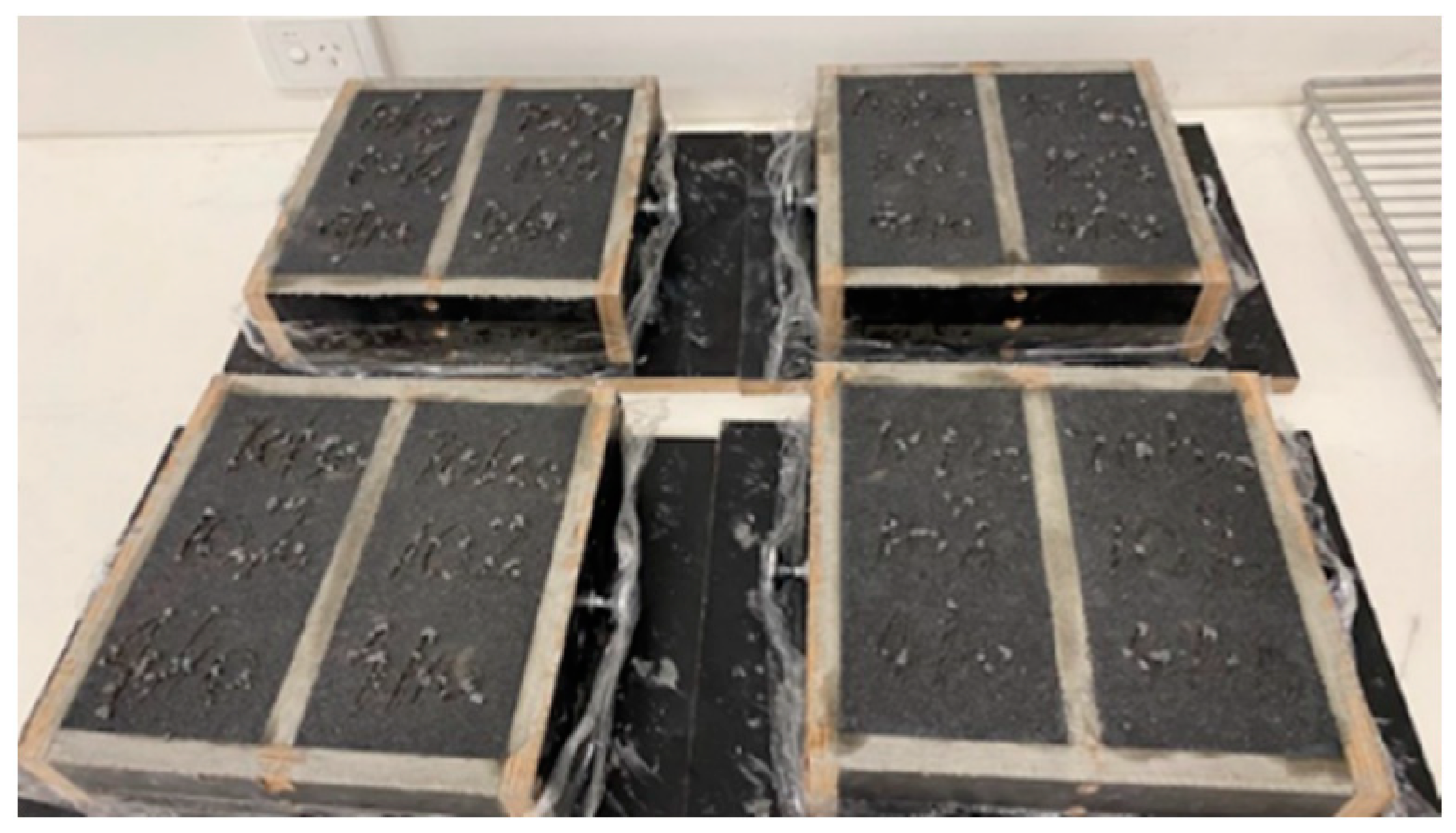
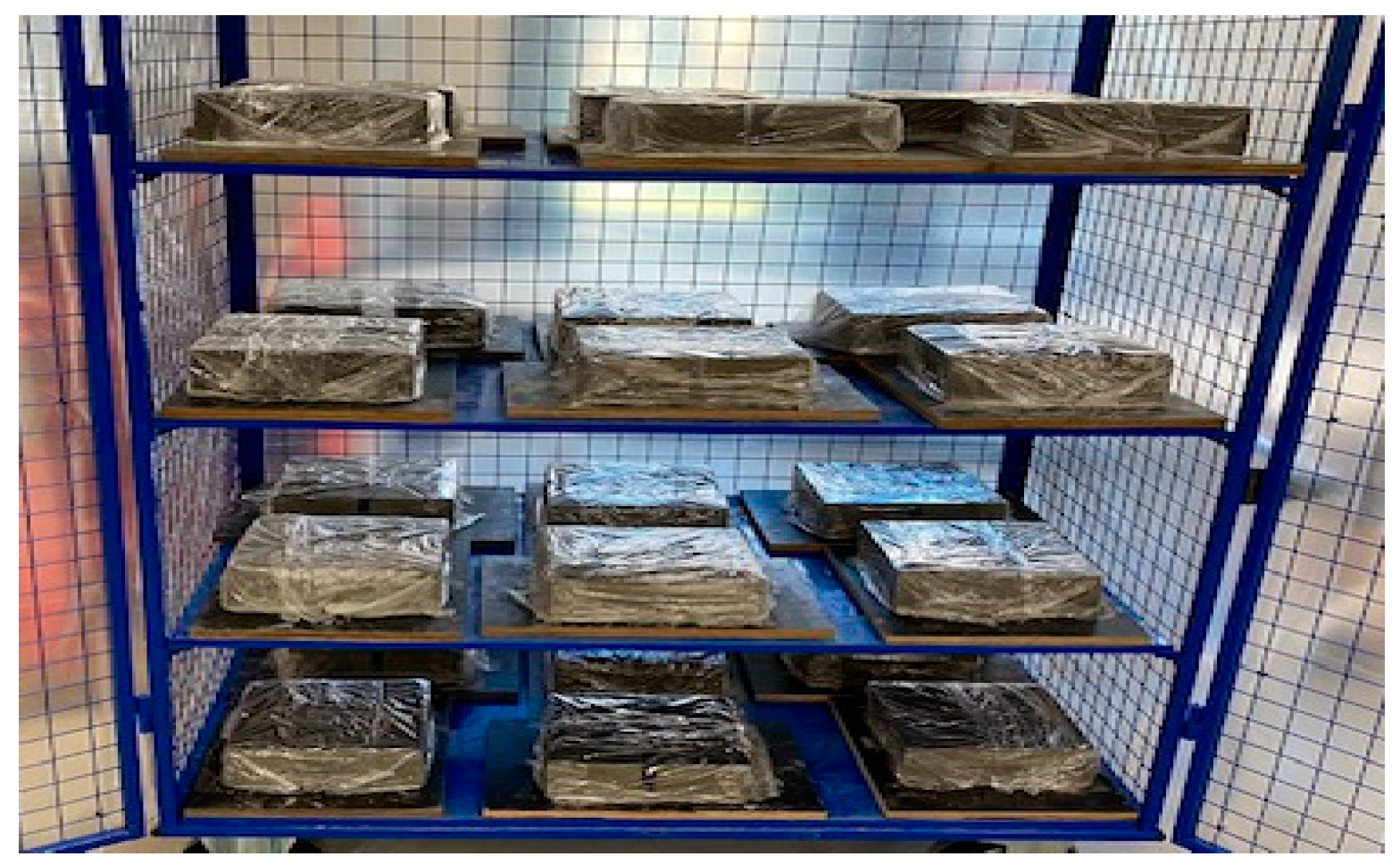

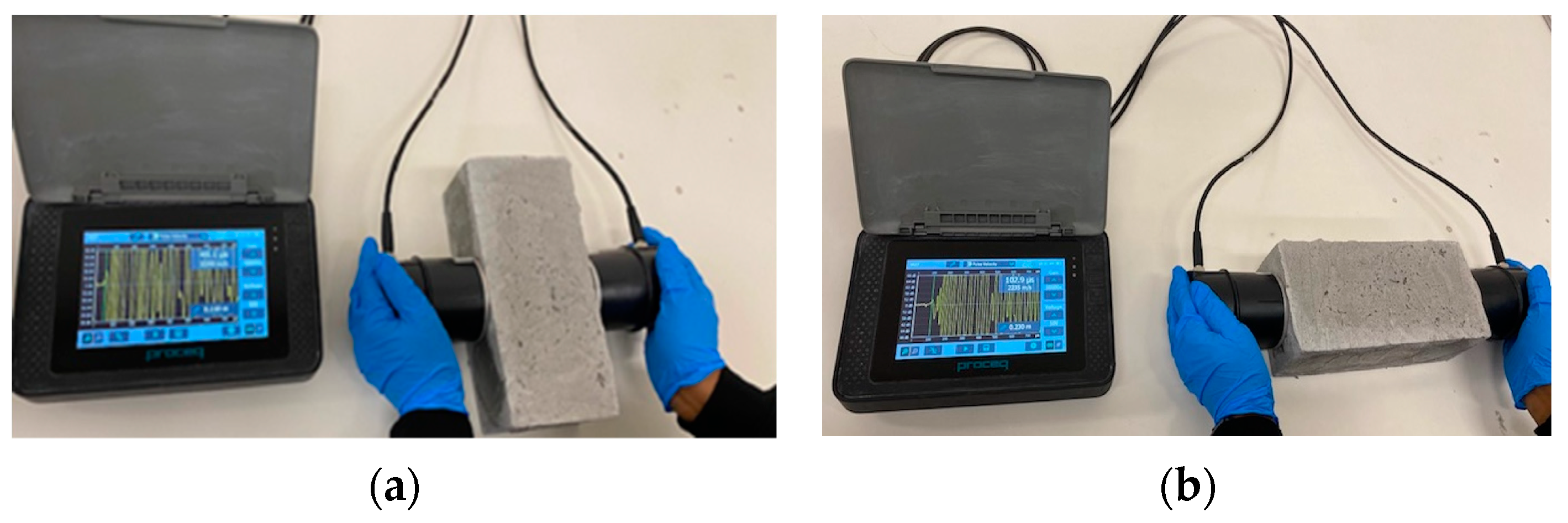


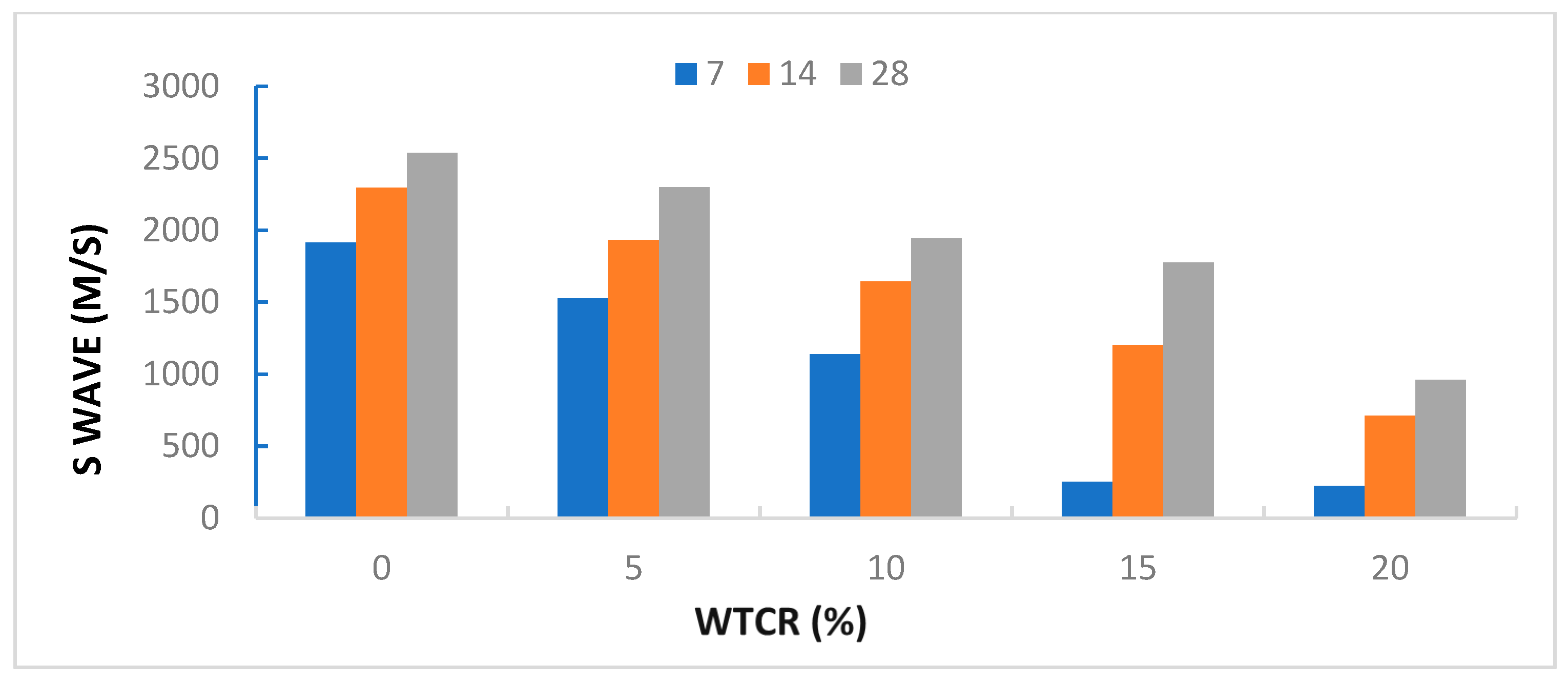
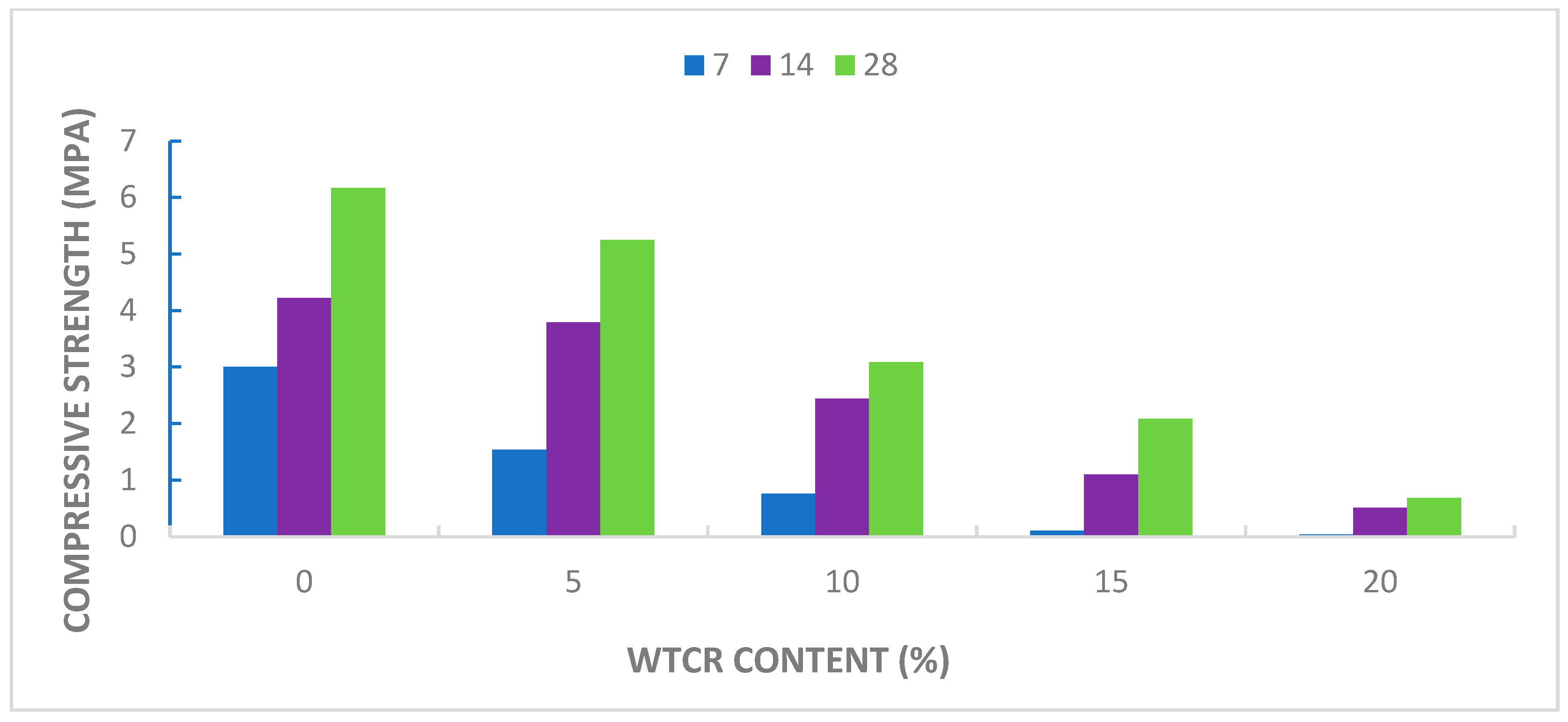


| SCM:Fine Aggregate Ratio | SCM Blend Ratio (%) (LKD:GGBFS) | Materials | CS (MPa) | |
|---|---|---|---|---|
| LKD:GGBFS (g) | Sand (g) | |||
| 1:3 | 90:10 | 1620:180 | 5400 | 1.67 |
| 1:3 | 80:20 | 1440:360 | 5400 | 3.69 |
| 1:3 | 70:30 | 1260:540 | 5400 | 6.17 |
| 1:3 | 60:40 | 1080:720 | 5400 | 10.49 |
| 1:3 | 50:50 | 900:900 | 5400 | 8.71 |
| 1:3 | 40:60 | 720:1080 | 5400 | 11.94 |
| 1:3 | 30:70 | 540:1260 | 5400 | 12.04 |
| Mathematical Correlation | P Wave | S Wave | ||
|---|---|---|---|---|
| Correlation Coefficient | Model | Correlation Coefficient | Model | |
| Linear | R2 = 0.9162 | fc = 0.0021V − 1.517 | R² = 0.8654 | fc = 0.0025V − 1.3399 |
| Exponential | R2 = 0.7702 | fc = 0.0751e0.0015V | R² = 0.9122 | fc = 0.0734e0.0019V |
| Logarithmic | R2 = 0.7332 | fc = 2.6107ln(V) − 16.944 | R² = 0.6206 | fc = 1.9959ln(V) − 11.886 |
| Power | R2 = 0.9604 | fc = 6 × 10−8V2.2933 | R² = 0.9591 | fc = 2 × 10−6V1.8985 |
| Experimental CS (MPa) from Compression | P Wave Predicted CS (MPa) Using Power Model | S Wave Predicted CS (MPa) Using Power Model |
|---|---|---|
| 3.23 | 2.616 | 3.408 |
| 1.54 | 1.634 | 2.217 |
| 0.76 | 0.730 | 1.267 |
| 0.1 | 0.120 | 0.072 |
| 0.04 | 0.053 | 0.059 |
| 4.22 | 4.507 | 4.810 |
| 3.79 | 3.776 | 3.461 |
| 2.44 | 2.591 | 2.553 |
| 1.1 | 1.273 | 1.406 |
| 0.51 | 0.324 | 0.518 |
| 6.17 | 7.598 | 5.813 |
| 5.25 | 4.762 | 4.819 |
| 3.09 | 3.772 | 3.504 |
| 2.08 | 2.563 | 2.945 |
| 0.68 | 0.623 | 0.919 |
| P Wave (m/s) | CS (Demirboga et al. [63]) | CS (Mohammed et al. [35]) | CS (Aliabdo and Elmoaty [26]) | Experimental CS (MPa) from Compression |
|---|---|---|---|---|
| 2144 | 0.583 | 9.762 | 1.779 | 3.23 |
| 1746 | 0.263 | 7.01 | 1.765 | 1.54 |
| 1229 | 0.093 | 4.695 | 1.745 | 0.76 |
| 560 | 0.025 | 2.749 | 1.701 | 0.1 |
| 391 | 0.017 | 1.812 | 1.678 | 0.04 |
| 2718 | 1.836 | 15.451 | 1.792 | 4.22 |
| 2516 | 1.226 | 13.145 | 1.788 | 3.79 |
| 2135 | 0.572 | 9.692 | 1.78 | 2.44 |
| 1566 | 0.183 | 6.148 | 1.762 | 1.1 |
| 862 | 0.045 | 3.5 | 1.727 | 0.51 |
| 3413 | 7.372 | 26.941 | 1.804 | 6.17 |
| 2784 | 2.095 | 16.289 | 1.794 | 5.25 |
| 2515 | 1.223 | 13.135 | 1.788 | 3.09 |
| 2125 | 0.561 | 9.614 | 1.779 | 2.08 |
| 1147 | 0.079 | 4.397 | 1.744 | 0.68 |
Disclaimer/Publisher’s Note: The statements, opinions and data contained in all publications are solely those of the individual author(s) and contributor(s) and not of MDPI and/or the editor(s). MDPI and/or the editor(s) disclaim responsibility for any injury to people or property resulting from any ideas, methods, instructions or products referred to in the content. |
© 2023 by the authors. Licensee MDPI, Basel, Switzerland. This article is an open access article distributed under the terms and conditions of the Creative Commons Attribution (CC BY) license (https://creativecommons.org/licenses/by/4.0/).
Share and Cite
Oke, J.A.; Abuel-Naga, H. Assessment of a Non-Destructive Testing Method Using Ultrasonic Pulse Velocity to Determine the Compressive Strength of Rubberized Bricks Produced with Lime Kiln Dust Waste. Geotechnics 2023, 3, 1294-1308. https://doi.org/10.3390/geotechnics3040070
Oke JA, Abuel-Naga H. Assessment of a Non-Destructive Testing Method Using Ultrasonic Pulse Velocity to Determine the Compressive Strength of Rubberized Bricks Produced with Lime Kiln Dust Waste. Geotechnics. 2023; 3(4):1294-1308. https://doi.org/10.3390/geotechnics3040070
Chicago/Turabian StyleOke, Joy Ayankop, and Hossam Abuel-Naga. 2023. "Assessment of a Non-Destructive Testing Method Using Ultrasonic Pulse Velocity to Determine the Compressive Strength of Rubberized Bricks Produced with Lime Kiln Dust Waste" Geotechnics 3, no. 4: 1294-1308. https://doi.org/10.3390/geotechnics3040070







